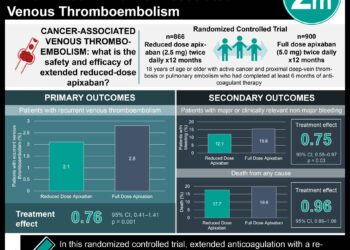Utility of D-dimer testing and modified thresholds for ruling out pulmonary embolism in COVID-19 patients
1. The D-dimer test threshold of 0.05 µg/mL in COVID patients had a sensitivity of 100%, a specificity of 8.8%, a negative predictive value of 100%, a positive predictive value of 13.9%, and negative likelihood ratio of <0.1 for prediction of pulmonary embolism.
2. The use of current D-dimer cutoffs was a very poor screening test for excluding PE in patients with COVID-19.
Evidence Rating Level: 3 (Average)
Study Rundown: Plasma D-dimer assay has been used to rule out pulmonary embolism (PE) in patients with a low pre-test probability. The D-dimer test was not validated in COVID patients, but further study in the area is needed as COVID-19 patients are at an increased risk of thrombosis and can have elevated D-dimer without thrombosis. This study assessed the diagnostic accuracy of the D-dimer test at excluding PE in hospitalized COVID-19 patients. In a sample of COVID patients that had D-dimer testing, those with strongly suspected PE also received computed tomographic pulmonary angiography (CTPA). These two groups were compared for the sensitivity and specificity of the D-dimer threshold of 0.05 µg/mL or one that is age-adjusted (D-dimer threshold = 0.01 × [age – 50 years]) at predicting PE. 92.3% of the COVID patients that had suspected PE had a plasma D-dimer of at least 0.05 µg/mL. 12.9% of patients with suspected PE had this diagnosis confirmed by CTPA, all of whom met the D-dimer threshold. The patients with confirmed PE had higher average D-dimer values than those not diagnosed with PE. The D-dimer test threshold of 0.05 µg/mL had a sensitivity of 100% and 8.8% specificity. Using the age-adjusted formula of for threshold D-dimer or a threshold of 20 µg/mL improved the specificity at the cost of the sensitivity. Thus, the use of current D-dimer cutoffs was a very poor screening test for excluding PE in patients with COVID-19. A strength of this study was the comparison of a large sample of COVID patients. Additionally, this study attempts to probe the clinical utility of D-dimer testing in COVID patients, which is necessary for resource stewardship. However, this study lacks a classification of COVID patients included in its sample.
Click to read the study in JAMA Network Open
Relevant Reading: D-dimer level in COVID-19 infection: a systematic review
In-Depth [cross-sectional study]: 1541 patients hospitalized with COVID-19 had their data on D-dimer concentrations compared to the subset of 287 COVID patients with suspected PE that also received CTPA. The static and age-adjusted threshold of D-dimer to correctly predict the diagnosis of PE was evaluated. Of the 287 COVID patients with suspected PE that received CTPA, 41.1% were in the intensive care unit and 9.4% died during their hospital stay (51.4% men, age = 58.2±16.1 years). In those that received CTPA, 92.3% had a plasma D-dimer of at least 0.05 µg/mL, including all the 12.9% of patients with radiographic evidence of PE on CTPA (average D-dimer = 6.1 µg/mL, range = 0.5–>10000 µg/mL vs 1.0 µg/mL and 0.2–128 µg/mL, respectively in those without radiographic evidence of PE). Patients without PE had a statistically lower D-dimer than those with PE (8.7±11.6 µg/mL vs 1.2±2.8 µg/mL, P < 0.001). The threshold D-dimer concentration of 0.05 µg/mL was found to have a sensitivity of 100% for PE, a specificity of 8.8%, a negative predictive value (NPV) of 100%, a positive predictive value (PPV) of 13.9%, and negative likelihood ratio (NLR) of <0.1. The D-dimer age-adjusted threshold had a sensitivity of 94.6%, specificity of 22.8%, NPV of 96.6%, PPV of 13.9%, and NLR of 0.24. There was no difference in the receiver operator characteristic curves between the D-dimer threshold that was and was not age-adjusted (0.81 vs 0.80, P = 0.67). Other tested thresholds suggested that the threshold of 20 µg/mL had improved specificity of 96.6% and accuracy of 86.7% at the cost of sensitivity being 20.0%, with a positive likelihood ratio (PLR) of 5.90 and NLR of 0.57.
Image: PD
©2021 2 Minute Medicine, Inc. All rights reserved. No works may be reproduced without expressed written consent from 2 Minute Medicine, Inc. Inquire about licensing here. No article should be construed as medical advice and is not intended as such by the authors or by 2 Minute Medicine, Inc.








